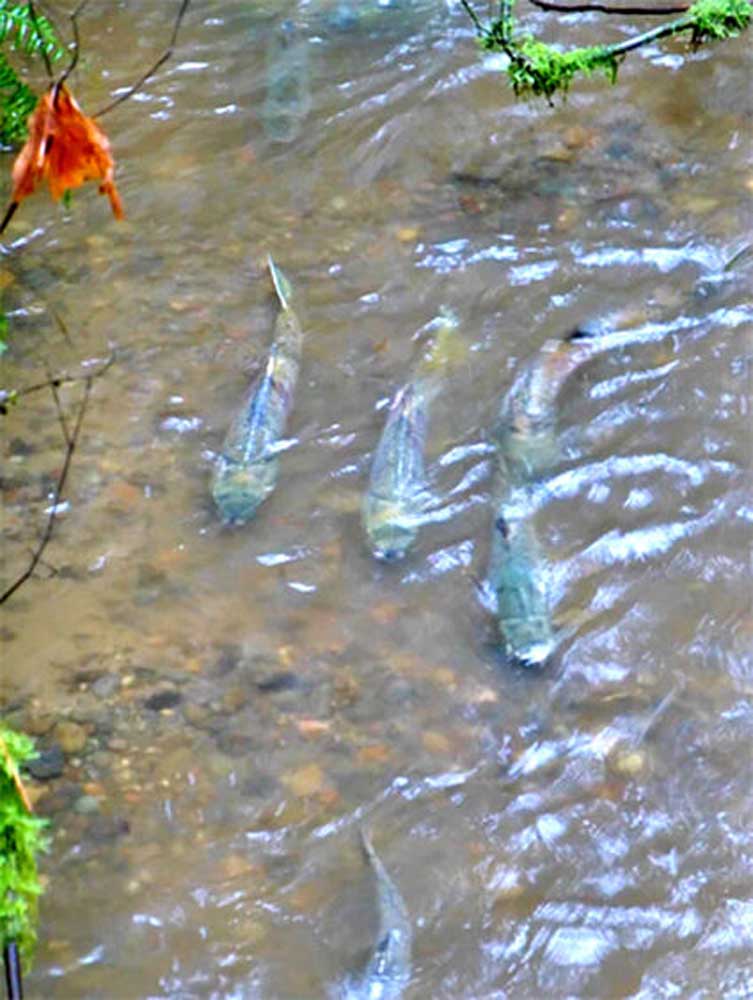Learn to love Washington’s ‘amazing’ late salmon runs
Published 1:55 pm Wednesday, December 22, 2021

- These are some of the chum salmon who survived the journey up a small Washington creek.
Sleek dark shapes moved back and forth in the shallow water of Kennedy Creek. There were hundreds of them massing in this tiny tributary when I visited back in early November. It was incredible. Carcasses were stuck on sticks and logs that jutted into the stream. I couldn’t believe so many fish could spawn in such tiny waters! The annual migration of our salmon is an astounding thing to witness when you find the opportunity.
Trending
Surprisingly, many streams in Washington possess salmon runs visible at this time of the year if you know when and where to look. Sometimes, salmon are easily seen, particularly where the water is shallow and clear enough, often along a shallow, gravel-topped riffle. Autumn typically starts out with these conditions — clear water with lower levels than spring, when other salmon run — so it is the best time to see them.
We have five species of salmon in Washington; Chinook (king), coho (silver), chum (dog), pink (humpy) and sockeye (red). All are truly anadromous, which means born in fresh water, grow in salt water and return to fresh to spawn, and in the case of Pacific salmon, die after spawning. It is an amazing set of life histories that help define what it means to live in Washington. And many subtle variations exist between species, part of the river system they occupy, barriers and timing.
These fish are amazing travelers and endure remarkable odds to make it back. It is estimated that only about 1 in 1,000 eggs survives to become a returning adult. A big Chinook can lay 2,000 to 4,000 eggs in her one chance at spawning, so we know why they lay so many! Everything tries to eat salmon eggs and fry (young salmon). Kingfishers, mergansers, other fish (like bull trout or bass), even some invertebrates, such as dragonflies. And I didn’t even mention all of the ocean predators going after adult salmon: orcas, sea lions, sharks, humans!
Trending
Salmon are a very, very important link in so many food webs — not to mention the critical pulse of “marine-derived nutrients” that come back to rivers in the form of dead salmon. These carcasses are now known to be very important to our connected ecosystems.
‘It’s not so much amazing that they come back, it’s amazing they come back at all after all we have put them through.’
One fish biologist friend quipped, “It’s not so much amazing that they come back, it’s amazing they come back at all after all we have put them through.”
In early November, some of the streams in Western Washington (especially Willapa Bay and south Puget Sound) get the remarkable pulse of chum, or dog, salmon. These are the ones that come in all at once, and when the fall rains come, sometimes seek out flooded areas for remote spawning. They are filmed crossing certain flooded roads and make the evening news! Onchyrhncus nerka. Big. Hooked jaws and dog-like teeth. Amazing colorful splotches on their sides in freshwater (they are bright silver at sea). Chum don’t spend much time in the streams as juveniles, and grow up in estuary habitats. These fish are still abundant in many waters. Look for them at the Kennedy Creek salmon interpretive site near Olympia featured on the South Sound Salmon Enhancement Group website. Around Willapa Bay, chum return to Bear River, Ellsworth Creek and other small coastal streams.
Coho (onchyrhynkus kisutch, or silver salmon) come into many streams in the fall as well. They seek out low-gradient places with good gravel and hiding cover. They can even get over beaver dams when the flows are right! Coho, and all of the other species, were once super-abundant throughout salmon-bearing waters in Washington, but numbers have been diminished for a long time.
Sockeye, who need lakes in their story, make spectacular appearances in a few places too, such as Issaquah and Lake Washington. The famed Bristol Bay fishery in Alaska features several amazing lakes that these fish use, much like some of the lakes in our Northwest.
Everyone wants to keep salmon in our landscape. But, salmon recovery is a complex undertaking, with many elements and players. They are being helped in their comeback by many entities, including the various Regional Fisheries Enhancement Groups, Tribes across the state, the Washington Department of Fish and Wildlife, the Washington State Department of Natural Resources, the timber industry, counties, conservation districts, numerous nonprofits working with fisheries, and of course, our small forest landowners.
Streams protected by small forest landowners are an essential link in keeping these fish on the landscape. Stream buffers and safe passage structures (bridges, adequately sized culverts) are helping our fish immensely. The Forests and Fish Agreement from way back in the late 20th Century has been a cornerstone for forest management to help with salmon recovery. If you think you may have a fish barrier on your property, check out the Family Forest Fish Passage Program here at DNR!
Salmon are having a bad time, with changing ocean conditions, loss of habitat for spawning and rearing (places for baby salmon to hide and grow up before migrating to the sea), over-harvest, blockages to migration, etc. etc. etc. It is an ongoing, long-term effort to help them recover numbers and to keep them in our streams. Salmon are a part of our Northwestern heritage we don’t want to lose.
When you see that dead salmon floating along the edge of a stream at this time of the year, be grateful for them. They are amazing and worth helping.









